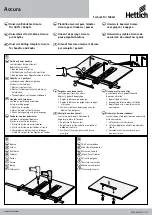
Blizzard Turbo Split System Manual
SAFETY
L-3448 ENGLISH
3
operation of any Dometic product or group of Dometic products. All electrical connections must be covered and protected so
accidental contact cannot be made by persons using the equipment, as such contact could be LETHAL.
GAS
- Dometic Air Conditioning and Refrigeration components utilize R-134A refrigerant (Tetrafluoroethane), R-407C (which
contains Diflouromethane [HFC-32], Pentafluoroethane [HFC-125], and1.1.1.2-Tetrafluoroethane [HFC-134A]), R-404A (R-125/
R-143A/R-134 [44%/52%/4%]), or R-417A, which are non-toxic, non-flammable gases; however, these gases contain no
oxygen and will not support life. Refrigerant gas tends to settle in the lowest areas of the compartment. If you experience a leak,
evacuate all personnel, and ventilate area. Do not allow open flames in the area of leaks because refrigerant gas, when burned,
decomposes into other potentially LETHAL gases. Refrigerant components operate at high pressure and no servicing should be
attempted without gloves, long-sleeved clothing and eye protection. Liquid refrigerant gas can cause severe frost burns to the
skin and eyes.
VENTILATION
- To cool or heat air, Dometic Air Conditioning and Refrigeration components are designed to move air through a
heat exchanger by a blower or propeller fan. This design necessarily produces a suction on one side of the air handling
component and a pressure on the other side. Air handling components must be installed so that the suction-pressure action
does not: (1) pressurize an area to the extent that structural failure occurs which could cause harm to occupants or bystanders,
or (2) cause a suction or low pressure in an area where hydrogen gas from batteries, raw fuel vapor from fuel tanks, carbon
monoxide from operating propulsion engines, power generators or heaters, methane gas from sewage holding tanks, or any
other dangerous gas or vapor could exist. If an air handling unit is installed in such a manner that allows potentially lethal gases
or vapors to be discharged by the air handling unit into the living space, this could result in loss of life.
Maximum protection against the introduction of dangerous gases or vapors into living spaces can be obtained by providing
living spaces which are sealed from all other spaces by use of airtight bulkheads and decks, etc., and through the introduction of
clean air into the living space. Bear in mind that the advent of air conditioning, whether it be for cooling or for heating, naturally
leads to the practice of closing a living space tightly. Never close all windows and doors unless auxiliary ventilating systems,
which introduce clean outside air into the living space, are used. Always leave enough window and door openings to provide
adequate ventilation in the event potentially lethal gases or fumes should escape from any source.
CONDENSATE
- All cooling units produce water condensate when operating on the cooling cycle. This water must be drained
from the cooling unit. If condensate is allowed to drip on a steel structure, rotting or decay and structural failure may occur which
could result in loss of life. If condensate is allowed to drip on electrical components, deterioration of the electrical components
could result in hazardous conditions. When an air conditioning system is in operation, condensate drains may be subjected to
negative pressure. Always locate condensate drains as far as possible from points where engine waste and other dangerous
gases are exhausted so no such dangerous gases can be drawn into the condensate drains.
Warning Revised: 6-5-06
S
AFE
H
ANDLING
OF
R
EFRIGERANTS
These warnings can not cover every conceivable situation, but they should serve as a useful guide.
WARNING
Never sleep in a closed area in a vehicle when any equipment, which functions as a result of the combustion of a
volatile fuel, is in operation (such as engines, generators, power plants, or oil-fired heaters, etc.). At any time, the
exhaust system of such devices could fail, resulting in a build-up of LETHAL gases within the closed area.
WARNING
To avoid possible explosion, death, or injury, practice safe handling of refrigerants.
WARNING
Refrigerants are heavier than air. They can “push out” the oxygen in your lungs or in any enclosed space. To avoid
possible death or difficulty breathing:
•
Never sniff a refrigerant.
•
Never purge refrigerant into an enclosed room or space. All refrigerants must, BY LAW, be reclaimed.
•
If an indoor leak is suspected, thoroughly ventilate the area before beginning work.
•
Liquid refrigerant can be very cold. To avoid possible frostbite or blindness, avoid contact and wear gloves and
goggles. If liquid refrigerant does contact your skin or eyes, get medical help immediately.
•
Never burn refrigerant, as poisonous gas will be produced.
•
Always follow EPA regulations.





































